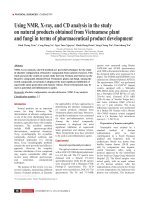Studies on variability, correlation and path analysis in red ripe chilli genotypes
Bạn đang xem bản rút gọn của tài liệu. Xem và tải ngay bản đầy đủ của tài liệu tại đây (578.1 KB, 9 trang )
Int.J.Curr.Microbiol.App.Sci (2019) 8(4): 1604-1612
International Journal of Current Microbiology and Applied Sciences
ISSN: 2319-7706 Volume 8 Number 04 (2019)
Journal homepage:
Original Research Article
/>
Studies on Variability, Correlation and Path Analysis in
Red Ripe Chilli Genotypes
Paramjeet Singh Negi* and Akhilesh Sharma
Department of Vegetable Science and Floriculture, CSK Himachal Pradesh Krishi
Vishvavidyalaya, Palampur, 176062, India
*Corresponding author
ABSTRACT
Keywords
Path analysis,
Red ripe chilli,
Genotypes
Article Info
Accepted:
12 March 2019
Available Online:
10 April 2019
The experimental material comprised of 33 genotypes including ‘Surajmukhi’ as standard
check was evaluated in randomized complete block design with three replications during
summer-rainy season 2017. The estimates of PCV and GCV were high for dry fruit
yield/plant and it also showed high heritability coupled with high genetic advance along
with marketable red ripe fruit yield/plant, non- marketable red ripe fruits/plant, dry fruit
yield/plant and oleoresin content. Majority of the traits showed high heritability along with
moderate estimates of PCV, GCV and genetic advance. Correlation studies revealed that
marketable red ripe fruit yield/plant showed positive association with fruit length, fruit
girth, fruit width, plant height, average red ripe fruit weight, marketable red ripe
fruits/plant, total red ripe fruits/plant, per cent marketable red ripe fruits/plant, average dry
fruit weight and dry fruit yield/plant at both the levels. Total red ripe fruits/plant directly
contributed maximum toward the marketable red ripe fruit yield/plant followed by per cent
marketable red ripe fruits/plant contributed directly to a limited extent at both phenotypic
and genotypic levels. Thus, indicating direct selection for these traits as a criterion for
yield improvement in chilli.
Introduction
Chilli is one of the common and remunerative
cash crops grown for its green and dry red
fruits. It is an indispensable spice due to its
pungency, taste, colour and flavor in every
house of the tropical world and has its unique
place in the diet both as a vegetable and spice
crop (Gadaginmath, 1992). Today, India has
emerged as the major producer, consumer and
exporter of chilli. It is presently grown
extensively throughout the country both under
rainfed and irrigated conditions in almost all
the states and contributes almost one fourth of
the world production. In India, green and dry
chilli covers an area of 0.032 and 0.084
million hectares with annual production of
3.634 and 2.096 million tonnes, respectively
during 2017-18. The initial and cheapest input
to enhance the productivity of any crop is to
make available high yielding and well
adapted varieties by initiating a strong
breeding programme. Genetic variability in
germplasm decides the level of success in the
improvement of such germplasm through
selection and provides the possibility to
1604
Int.J.Curr.Microbiol.App.Sci (2019) 8(4): 1604-1612
improve the yield and quality through
strategic
breeding
programme.
Crop
improvement with heritable characters,
estimation of genetic parameters and their
association is of prime importance in breeding
(Bozokalfa et al., 2010). The estimate of
heritability acts as a predictive instrument in
expressing the reliability of phenotypic values
and it helps the plant breeders to make
selection for a particular character when
heritability is high in magnitude (Unche et al.,
2008).
Effective improvement in yield may be
brought about through selection for yield
component characters (Alkuddsi et al., 2013).
Favourable associations between desirable
attributes will help improvement in a joint
manner whereas, unfavourable associations
between the desirable attributes under
selection may limit genetic advance.
Knowledge of correlation alone is often
misleading as the correlation observed may
not be always true. Simple correlation
analysis that relates yield to a single variable
may not provide a complete understanding of
the importance of each component in
determining fruit yield (Okuyama et al.,
2004).
Path coefficient analysis allows an effective
means of partitioning correlation coefficients
into unidirectional pathway and alternate
pathways. This analysis permits a critical
examination of specific factors that produce a
given correlation and can be successfully
employed in formulating an effective
selection strategy. Selection based on the
detailed knowledge of magnitude and
direction of association between yield and its
attributes is very important in identifying the
key characters, which can be exploited for
crop improvement through suitable breeding
programme. Keeping this in view, the present
investigation was carried out to evaluate 33
genotypes for red ripe fruit yield and related
horticultural traits.
Materials and Methods
The experiment was undertaken at the
Experimental Farm of Department of
Vegetable
Science
and
Floriculture,
Chaudhary Sarwan Kumar Himachal Pradesh
Krishi Vishvavidyalaya, Palampur during
summer 2017. The study location was situated
at an elevation of 1, 290.8 m above mean sea
level with 320 6′ N latitude and 760 3′ E
longitude represents the mid-hill zone of
Himachal Pradesh with annual precipitation
of 2,500 mm. The soil is classified as
Alfisolstypic Hapludalf clay having a pH of
5.7. The experimental material comprised of
27 F7 advanced line derived from eight
intervarietal crosses, five entries from AICRP
on Vegetable Crops and recommended variety
‘Surajmukhi’ as the standard check. Seed of
33 genotypes was sown in the nursery bed of
size 3 m × 1 m × 15 cm on 14th March 2017
and were tra planted on 7th May 2017 in
randomized complete block design with three
replications. Each genotype was planted in
two rows of length 2.25 m consisting of ten
plants in each replication with inter and intra
row spacing of 45 cm × 45 cm, respectively.
The observations were recorded on five
competitive plants taken at random over the
replications on days to flowering, pedicel
length, fruit length, fruit girth, fruit width, leaf
length, leaf width, plant height, primary
branches per plant, secondary branches per
plant, average red ripe fruit weight,
marketable red ripe fruits per plant, nonmarketable red ripe fruits per plant, total red
ripe fruits per plant, per cent marketable red
ripe fruits per plant, red ripe fruit yield per
plant, average dry fruit weight, dry fruit yield
per plant, oleoresin and capsaicin content.
The genotypic and phenotypic correlations
were calculated as per Al- Jibouri et al.,
(1958) by using analysis of variance and
covariance matrix in which total variability
had been splitted into replication, genotypes
1605
Int.J.Curr.Microbiol.App.Sci (2019) 8(4): 1604-1612
and errors. Path coefficient was obtained
according to the procedure elaborated by
Dewey and Lu (1959).
Results and Discussion
The knowledge of PCV and GCV is helpful in
predicting the amount of variation present in
the germplasm which helps in formulating an
efficient breeding programme (Table 1).
Phenotypic coefficient of variation (PCV) was
slightly higher than the genotypic coefficient
of variation (GCV) for all the characters
studied which indicated that environment also
played a considerable role in expression of
these characters (Kumar et al., 2014 and
Pandit and Adhikari, 2014). PCV and GCV
were high for dry fruit yield/ plant indicating
sufficient variability ensuring ample scope for
improvement of these traits through selection
(Pujar et al., 2017; Nahak et al., 2018).
Moderate estimates of PCV and GCV were
observed for most of the characters namely,
fruit length, secondary branches/plant,
average red ripe fruit weight, marketable red
ripe fruits/plant, red ripe fruit yield/plant,
non- marketable red ripe fruits/plant, total red
ripe fruits/plant, average dry fruit weight,
oleoresin and capsaicin contents indicating
that selection for these traits should be taken
up with cautions (Pandit and Adhikary,, 2014;
Pujar et al., 2017).
Heritability knowledge influences the choice
of breeding procedures to predict gain from
selection and to determine the relative
importance of genetic effects (Laghari et al.,
2010). Estimates of heritability are helpful in
studying the inheritance of quantitative
characters and also important for planning
breeding programmes with desired degree of
expected genetic progress. High heritability
estimates were observed for 70 per cent of the
characters studied namely, fruit length, leaf
length, leaf width, plant height, average red
ripe fruit weight, marketable red ripe
fruits/plant, red ripe fruit yield/plant, nonmarketable red ripe fruits/plant, total red ripe
fruits/plant, per cent marketable red ripe
fruits/plant, average dry fruit weight, dry fruit
yield/plant, oleoresin and capsaicin content
indicating greater role of genetic components
of variation and lesser influence of
environment (Kadwey et al., 2015; Meena et
al., 2016).
These characters with high heritability needs
to be given due emphasis as they are under
genetic control. However, high heritability
does not necessarily mean high genetic gain
and heritability in alone is insufficient to
make predictions for improvement through
simple phenotypic selection.
High heritability along with high genetic
advance was observed for red ripe fruit
yield/plant, non- marketable red ripe
fruits/plant, dry fruit yield/plant and oleoresin
content (Yatung et al., 2014; Pujar et al.,
2017) suggesting the presence of additive
gene action. High heritability along with
moderate genetic advance was observed for
majority of the traits namely, fruit length, leaf
length, leaf width, plant height, average red
ripe fruit weight, marketable red ripe
fruits/plant, total red ripe fruits/plant, average
dry fruit weight and capsaicin content
indicating the importance of additive and nonadditive gene action (Bijalwan and Naidu
2013, Megharaj et al., 2017).
The success of selection program depends
upon the magnitude and direction of
association between the trait of interest and
yield. After attaining the knowledge of nature
and magnitude of genetic variation, it would
be important to gather information on
association of yield with other characters and
among themselves. Genotypic correlation
coefficients were higher in magnitude than
the corresponding phenotypic ones (Table 2).
1606
Int.J.Curr.Microbiol.App.Sci (2019) 8(4): 1604-1612
Table.1 Estimates of parameters of variability for various traits in red chilli
Traits
Environment
variance
Phenotypi
c variance
Genotypic
variance
33.33-42.67
38.01
6.92
9.42
2.50
6.92
4.16
8.08
26.56
4.42
Pedicel length (cm)
2.24-4.17
3.34
0.07
0.31
0.24
7.64
14.71
16.57
78.83
26.90
Fruit Length (cm)
5.01-10.67
7.51
0.13
1.82
1.68
4.84
17.28
17.94
92.72
34.27
Fruit girth (cm)
2.72-4.09
3.50
0.03
0.16
0.13
5.27
10.29
11.54
79.45
18.89
Fruit width (cm)
0.78-1.19
1.01
0.01
0.01
0.01
7.65
8.97
11.60
59.82
14.30
Leaf length (cm)
6.14-9.98
8.14
0.07
1.46
1.40
3.20
14.51
14.86
95.33
29.18
Leaf width (cm)
2.58-4.55
3.58
0.05
0.32
0.27
6.05
14.56
15.77
85.27
27.69
Primary branches/plant
3.60-6.40
4.96
0.19
0.68
0.49
8.89
14.12
16.68
71.61
24.61
Secondary branches/plant
9.67-20.40
14.69
2.34
8.57
6.23
10.42
16.99
19.93
72.67
29.83
Plant Height (cm)
43.53-80.27
59.69
11.22
79.06
67.84
5.61
13.80
14.90
85.81
26.33
Harvest duration
46.00-61.00
57.43
7.87
24.40
16.53
4.88
7.08
8.60
67.74
12.00
Average red ripe fruit weight (g)
2.11-5.64
3.49
0.05
0.77
0.73
6.08
24.41
25.17
94.12
48.79
Marketable red ripe fruits/plant
16.70-45.30
34.26
5.10
66.89
61.79
6.59
22.95
23.88
92.38
45.44
Red ripe fruit yield/plant (g)
48.31-168.83
117.33
31.29
1084.76
1053.45
4.77
27.66
28.07
97.12
56.16
0.00-6.67
1.49
0.04
0.22
0.19
12.53
28.98
31.59
84.17
54.77
21.06-45.90
36.20
4.95
58.54
53.59
6.14
20.22
21.13
95.68
41.66
Per cent marketable red ripe fruits/plant
75.60-100
94.06
3.43
31.25
27.82
1.47
5.61
5.94
94.35
11.55
Average dry fruit weight (g)
0.35-0.81
0.55
0.00
0.02
0.02
8.08
24.55
26.05
88.82
47.66
Dry fruit yield/plant
5.33-29.50
17.36
6.24
33.70
27.46
14.39
30.19
33.45
81.48
56.15
Capsaicin content (%)
0.97-2.57
1.86
0.02
0.21
0.18
8.33
23.00
24.47
88.33
44.52
28.70-81.45
53.74
8.74
245.14
236.40
5.50
28.61
29.14
96.44
57.88
Non-marketable red ripe fruits/plant
Total red ripe fruits/plant
Oleoresin content (ASTA units)
ECV
(%)
PCV and GCV represent phenotypic and genotypic coefficients of variation, respectively; h 2 bs: Heritability in broad sense; GA (%): Genetic advance (%) of mean
1607
GCV
(%)
PCV
(%)
h2bs
Population
mean ±
S.E
Days to flowering
Ranges
GA
(%)
Int.J.Curr.Microbiol.App.Sci (2019) 8(4): 1604-1612
Table.2 Estimates of phenotypic and genotypic correlation coefficients for different pair of traits in red chilli
Traits
Pedicel
length (cm)
Fruit
Length
(cm)
P
0.179
0.084
G
P
G
P
G
0.184
0.065
0.430 *
0.467 *
Fruit girth Fruit width Leaf length Leaf width Primary Secondary
Plant
Average Marketable
NonTotal red Percent
Average Dry fruit Capsaicin Oleoresin Marketable
(cm)
(cm)
(cm)
(cm)
branches/pl branches/pl Height (cm) red ripe
red ripe marketable ripe fruit/ marketable dry fruit yield/plant content (%) content
red ripe
ant
ant
fruit weight fruits/plant red ripe
plant
red ripe weight (g)
(ASTA
fruit
(g)
fruits/plant
fruit
units)
yield/plant
(g)
-0.018
0.092
-0.041
0.181
-0.040
-0.052
-0.036
-0.152
-0.184
-0.039
-0.283 *
-0.110
0.012
-0.262 *
-0.273 *
-0.036
-0.278 *
Days to flowering
Pedicel length(cm)
Fruit Length (cm)
Fruit girth (cm)
Fruit width (cm)
Leaf length (cm)
Leaf width(cm)
Primary
branches/plant
Secondary
branches/ plant
Plant Height (cm)
Average red ripe
fruit weight (g)
Marketable red
ripe fruits/ plant
Non-marketable
red ripe
fruits/plant
Total red ripe
fruit/plant
Percent
marketable red
ripe fruit
Average dry fruit
weight (g)
Dry fruit
yield/plant
Capsaicin content
(%)
Oleoresin content
(ASTA units)
P
G
P
G
P
G
P
G
P
G
P
G
P
G
P
G
P
G
P
G
-0.087
-0.036
-0.055
0.303 *
0.300 *
0.145
-0.114
-0.241*
0.211*
0.164
-0.046
0.006
0.015
0.176
0.198*
0.295 *
-0.119
-0.185
-0.059
-0.059
-0.073
-0.019
-0.014
-0.305 *
-0.331 *
-0.262 *
-0.210*
-0.228*
0.087
0.089
-0.017
0.328 *
0.406 *
0.476 *
0.518 *
-0.288 *
0.047
0.070
0.465 *
0.501 *
-0.405 *
-0.202*
-0.229*
-0.032
-0.031
-0.032
0.210*
0.261 *
0.058
0.048
-0.567 *
-0.154
-0.162
0.360 *
0.386 *
-0.251*
-0.216*
-0.264 *
0.068
0.082
0.036
-0.026
-0.023
0.260 *
0.307 *
-0.585 *
-0.170
-0.183
0.161
0.220*
-0.511 *
-0.196*
-0.230*
-0.162
-0.188
-0.062
-0.001
-0.011
-0.198*
-0.204*
-0.558 *
-0.160
-0.170
0.352 *
0.379 *
0.636 *
0.813 *
0.232*
0.283 *
-0.034
-0.002
0.204*
0.269 *
0.047
0.151
0.637 *
0.677 *
-0.094
-0.102
-0.201*
-0.254*
0.196
0.232*
0.025
0.031
-0.069
-0.085
0.115
0.170
-0.291 *
-0.315 *
-0.372 *
-0.399 *
-0.046
-0.016
0.397 *
0.437 *
0.164
0.176
-0.004
0.018
-0.061
0.003
-0.268 *
-0.336 *
-0.015
-0.088
0.561 *
0.648 *
0.417 *
0.566 *
0.080
0.082
0.075
0.094
-0.454 *
-0.513 *
0.026
-0.023
0.497 *
0.544 *
-0.135
-0.148
-0.132
-0.190
-0.002
-0.004
-0.021
-0.030
0.183
0.164
0.087
0.160
-0.090
-0.092
-0.314 *
-0.286 *
-0.111
-0.205*
-0.168
-0.257 *
-0.264 *
-0.297 *
-0.366 *
-0.407 *
-0.044
-0.031
0.129
0.170
0.092
0.098
-0.043
-0.049
-0.402 *
-0.433 *
0.396 *
0.450 *
0.278 *
0.368 *
0.030
0.030
0.043
0.050
-0.235*
-0.293 *
0.127
0.154
0.390 *
0.432 *
0.550 *
0.561 *
0.583 *
0.602 *
-0.286 *
-0.304 *
0.222*
0.308 *
0.157
0.228*
0.255*
0.267 *
0.330 *
0.350 *
-0.024
-0.047
-0.083
-0.099
0.070
0.089
0.272 *
0.289 *
0.537 *
0.560 *
-0.844 *
-0.854 *
0.395 *
0.480 *
0.373 *
0.508 *
0.014
0.015
-0.001
-0.017
-0.339 *
-0.457 *
-0.159
-0.205*
0.467 *
0.555 *
0.636 *
0.682 *
-0.333 *
-0.375 *
-0.034
-0.009
0.190
0.250*
0.241*
0.334 *
0.099
0.115
-0.095
-0.120
-0.075
-0.203*
0.083
0.097
0.230*
0.264 *
0.325 *
0.365 *
0.381 *
0.406 *
-0.142
-0.153
0.244*
0.268 *
0.080
0.108
0.440 *
0.472 *
0.391 *
0.453 *
0.098
0.138
-0.135
-0.107
0.113
0.107
0.171
0.191
0.014
0.012
-0.178
-0.223*
0.192
0.221*
-0.013
-0.008
0.055
0.059
-0.086
-0.111
0.404 *
0.467 *
-0.264 *
-0.321 *
0.039
0.047
-0.130
-0.131
0.000
-0.008
-0.138
-0.148
0.395 *
0.453 *
0.280 *
0.372 *
0.043
0.044
0.060
0.068
-0.228*
-0.286 *
0.118
0.143
0.381 *
0.423 *
0.545 *
0.555 *
0.594 *
0.613 *
-0.327 *
-0.342 *
0.592 *
0.610 *
0.258 *
0.264 *
0.065
0.047
0.667 *
0.716 *
0.270 *
0.290 *
0.160
0.184
0.242*
0.273 *
-0.144
-0.148
0.058
0.054
0.999 *
0.999 *
0.624 *
0.640 *
0.470 *
0.433 *
0.160
0.173
0.244*
0.290 *
0.075
0.072
-0.085
-0.111
0.136
0.151
0.255*
0.260 *
0.661 *
0.710 *
0.167
0.192
-0.135
-0.139
P
G
P
G
P
G
P
G
P
G
P
G
Residual effect at phenotypic level (P) =0.0061, and genotypic level (G) = 0.0029. Significant at P ≤0.05; bold values indicate direct effects; r correlation coefficient with marketable green fruit yield/plant
1608
Int.J.Curr.Microbiol.App.Sci (2019) 8(4): 1604-1612
Table.3 Estimates of direct and indirect effects of different traits on marketable red fruit yield per plant at phenotypic (P) and
genotypic (G) levels in red ripe chilli
Days to
flowering
Pedicel
length
(cm)
Fruit
Length
(cm)
Fruit
girth
(cm)
Fruit
width
(cm)
Leaf
length
(cm)
Leaf
width
(cm)
Primary
branches
per plant
Secondary
branches
per plant
Plant
Height
(cm)
Marketable
red ripe
fruits per
plant
0.000
0.000
Average
red ripe
fruit
weight
(g)
0.000
-0.012
Total
red ripe
fruits
per
plant
-0.278
-0.536
Percent
marketable
red ripe
fruit
Average
dry fruit
weight
(g)
0.000
-0.019
Nonmarketable
red ripe
fruits per
plant
0.001
0.001
P
G
-0.001
0.012
0.000
-0.002
0.000
0.000
0.000
0.001
0.000
0.003
0.000
-0.001
0.000
-0.005
0.000
0.000
0.000
0.003
-0.002
0.000
P
G
0.000
0.002
0.001
-0.010
0.000
0.000
0.000
0.001
0.000
-0.005
0.000
0.000
0.000
0.003
0.000
0.000
0.000
0.003
0.000
0.005
0.000
0.003
0.000
-0.011
-0.007
-0.007
-0.151
-0.153
Fruit Length
(cm)
P
G
0.000
0.001
0.000
-0.005
0.001
0.000
0.000
-0.004
0.000
0.003
0.000
0.002
0.000
0.001
-0.001
-0.002
0.000
-0.001
0.000
0.007
-0.001
0.021
0.000
-0.002
-0.002
-0.001
Fruit girth
(cm)
P
G
0.000
-0.001
0.000
0.001
0.000
0.000
0.000
-0.013
-0.001
0.015
0.000
0.003
0.000
-0.005
0.000
-0.001
0.000
0.001
0.000
0.006
-0.002
0.028
0.000
-0.007
Fruit width
(cm)
P
G
0.000
0.002
0.000
0.002
0.000
0.000
0.000
-0.010
-0.001
0.019
0.000
0.000
0.000
-0.003
0.000
-0.001
0.000
-0.002
0.000
0.002
-0.001
0.024
Leaf length
(cm)
P
G
0.000
-0.001
0.000
0.000
0.000
0.000
0.000
-0.004
0.000
0.000
0.000
0.010
0.001
-0.012
0.000
0.001
0.000
0.004
0.000
0.000
P
Leaf
G
width(cm)
Primary
P
branches per
G
plant
Secondary
P
branches per
G
plant
Plant Height (cm) P
G
Average red ripe P
fruit weight (g)
G
Marketable red
P
ripe fruits per
G
plant
Non-marketable P
red ripe fruits per G
plant
Total red ripe fruit P
per plant
G
Percent
P
marketable red
G
ripe fruit
Average DRY fruit P
weight (g)
G
Dry fruit yield per P
plant
G
Capsaicin content P
(%)
G
Oleoresin content P
(ASTA units)
G
0.000
0.003
0.000
0.002
0.000
0.000
0.000
-0.003
0.000
0.003
0.000
0.007
0.002
-0.018
0.000
0.000
0.000
0.005
0.000
-0.001
0.000
0.000
0.000
0.000
0.000
0.001
0.000
-0.005
0.000
0.002
0.000
-0.001
0.002
0.005
0.000
-0.003
0.000
0.002
0.000
0.000
0.000
0.001
0.000
0.003
0.000
-0.003
-0.001
0.007
0.000
0.000
0.000
-0.003
0.000
-0.005
0.000
-0.004
0.000
-0.001
0.000
0.002
0.001
0.000
0.001
0.000
0.000
0.000
0.000
-0.006
0.000
-0.008
0.000
0.002
0.000
0.003
0.000
0.011
0.000
-0.004
0.000
0.000
0.000
0.001
0.000
0.000
0.000
0.000
0.000
-0.003
0.000
0.000
0.000
0.003
0.000
-0.005
0.000
-0.007
0.000
-0.003
0.000
0.002
0.000
0.003
0.000
0.000
0.000
0.000
0.000
-0.006
0.000
-0.004
0.000
0.000
0.000
-0.007
0.000
-0.006
0.000
-0.001
0.000
0.000
0.000
0.002
0.000
0.002
0.000
0.000
0.000
0.000
0.000
0.000
0.000
0.000
0.000
0.000
0.000
-0.006
0.000
-0.003
0.000
-0.003
0.000
-0.003
Traits
Days to
flowering
Pedicel length
(cm)
Capsaicin
content
(%)
Oleoresin
content
(ASTA
units)
r
0.000
0.000
Dry
fruit
yield
per
plant
0.001
0.005
0.000
-0.007
0.000
0.000
-0.278*
-0.5584*
-0.004
0.000
0.000
0.000
0.001
0.002
0.000
-0.003
0.000
0.000
-0.160
-0.170
0.354
0.365
0.001
0.000
0.001
-0.004
-0.001
-0.002
0.000
-0.002
0.000
0.001
0.352*
0.379*
0.004
0.006
0.389
0.426
0.004
0.000
0.002
-0.006
-0.001
-0.002
0.000
0.003
0.000
-0.001
0.395*
0.453*
0.000
-0.009
0.005
0.007
0.274
0.348
0.003
0.000
0.002
-0.006
-0.001
-0.003
0.000
0.001
0.000
0.000
0.280*
0.372*
0.000
0.004
0.000
0.000
0.009
0.008
0.030
0.029
0.004
0.000
0.000
0.000
0.000
-0.001
0.000
0.006
0.000
0.000
0.043
0.044
0.000
0.000
0.000
0.004
0.000
-0.001
0.012
0.011
0.042
0.047
0.005
0.001
0.000
0.000
0.000
0.001
0.000
0.006
0.000
0.001
0.060
0.068
0.000
0.000
0.000
-0.004
0.001
-0.022
0.000
0.008
0.001
0.001
-0.231
-0.277
0.000
0.000
-0.001
0.005
0.000
0.002
0.000
0.002
0.000
-0.003
-0.228*
-0.286*
0.000
0.000
0.001
-0.013
0.000
-0.001
0.000
-0.001
0.000
0.008
-0.004
-0.005
0.125
0.146
-0.001
0.000
-0.001
0.002
0.000
-0.001
0.000
-0.001
0.000
0.002
0.118
0.143
0.000
0.000
0.000
-0.002
0.000
0.001
-0.001
-0.002
-0.001
-0.002
0.000
0.001
0.000
0.001
0.000
0.000
0.000
-0.002
0.000
0.013
0.000
0.007
0.000
-0.001
-0.001
0.023
-0.003
0.043
0.001
-0.012
0.000
-0.004
0.000
-0.014
0.000
0.048
-0.003
-0.003
0.001
0.001
0.013
0.012
0.383
0.408
0.541
0.530
0.574
0.570
0.001
0.000
0.004
0.000
0.009
0.001
0.002
-0.006
0.003
-0.008
-0.001
0.004
-0.001
-0.002
-0.001
-0.003
-0.002
-0.004
0.000
0.001
0.000
0.002
0.000
0.000
0.000
0.000
0.000
0.001
0.000
0.000
0.381*
0.422*
0.545
0.555*
0.594*
0.613*
0.000
-0.003
-0.001
0.008
0.000
0.000
0.000
-0.002
0.000
0.001
0.000
-0.002
0.000
-0.021
-0.032
-0.028
-0.281
-0.288
-0.014
-0.001
0.000
0.000
0.001
0.001
0.000
-0.003
0.000
0.001
-0.327*
-0.342*
0.000
0.007
0.000
0.004
0.000
0.000
0.000
0.003
0.000
-0.001
0.001
-0.006
0.000
-0.001
0.000
0.000
0.000
-0.002
0.000
0.001
0.000
0.005
0.000
0.001
-0.002
0.024
-0.001
0.012
0.000
0.029
0.000
0.027
0.009
0.009
0.027
0.024
0.983
0.946
0.582
0.577
0.010
0.001
0.016
0.001
0.001
-0.003
0.000
-0.001
-0.003
-0.006
-0.001
-0.003
0.000
0.002
0.000
0.004
0.000
0.001
0.000
0.000
0.999*
0.999*
0.624*
0.640*
0.000
0.010
0.000
0.006
0.000
0.002
0.000
0.000
0.000
0.000
0.000
0.001
0.000
0.005
0.000
0.001
0.000
0.000
0.000
0.002
0.001
-0.008
0.000
0.002
-0.001
-0.002
0.000
-0.001
0.000
0.001
0.001
0.002
0.000
0.003
0.000
-0.001
0.000
0.001
0.000
0.004
0.000
0.007
0.000
0.003
0.000
0.001
0.000
0.001
-0.002
0.029
-0.001
0.016
-0.001
0.008
0.000
-0.006
0.000
-0.018
0.000
0.019
0.000
0.001
0.000
0.000
0.001
0.000
0.005
0.004
0.006
0.006
0.005
0.004
0.254
0.250
0.656
0.678
0.157
0.174
-0.142
-0.140
0.001
0.000
0.004
0.000
0.004
0.000
0.001
0.000
0.004
-0.011
0.002
-0.005
0.001
-0.002
0.000
-0.001
-0.002
-0.004
-0.004
-0.009
-0.001
-0.003
0.000
0.001
0.000
0.002
0.000
0.004
0.000
0.013
0.000
0.002
0.000
0.000
0.000
0.001
0.000
-0.001
0.000
-0.005
0.255*
0.260*
0.661*
0.710*
0.166
0.192
-0.134
-0.139
Residual effect at phenotypic level (P) =0.0061, and genotypic level (G) = 0.0029. Significant at P ≤0.05; bold values indicate direct effects.;r correlation
coefficient with red fruit yield per plant
1609
Int.J.Curr.Microbiol.App.Sci (2019) 8(4): 1604-1612
Marketable red ripe fruit yield/plant showed
positive and significant correlation with fruit
length, fruit girth, fruit width, plant height,
average red ripe fruit weight, marketable red
ripe fruits/plant, total red ripe fruits/plant, per
cent marketable red ripe fruits/plant, average
dry fruit weight and dry fruit yield/plant at
both genotypic and phenotypic levels.
Similarly, dry fruit yield/plant revealed
positive association with fruit width, plant
height, average red ripe fruit weight,
marketable red ripe fruits/plant, total red ripe
fruits/plant, per cent marketable red ripe
fruits/plant, average dry fruit weight and
capsaicin content. Selection on the basis of
these traits might leads to higher yield as well
as these traits need to be given special focus
for the improvement of red and dry fruit yield.
Amongst the component traits, a positive and
significant association of average red ripe
fruit weight was observed with total red ripe
fruits/plant, per cent marketable red ripe
fruits/plant, average dry fruit weight, dry fruit
yield/plant, plant height, fruit girth, fruit
width and fruit length while marketable red
ripe fruits/plant showed positive correlation
with total red ripe fruits/plant, per cent
marketable red ripe fruits/plant and dry fruit
yield/plant. Similar desirable association was
observed for average dry fruit weight with dry
fruit yield/plant, fruit girth, fruit width, fruit
length and plant height and that of dry fruit
yield/plant with capsaicin content, plant
height and fruit width.
The end product, yield has often been
described as the product of its component
traits which show inter-dependence (Wilson
1987). The path coefficient analysis allows
partitioning of correlation coefficients into
direct and indirect effects of various traits
towards dependent variable and it helps in
determining the degree of relationship
between yield and its component effects. In
some cases, the direct effects were observed
to be of opposite at corresponding phenotypic
and genotypic levels like in days to flowering,
pedicel length, fruit girth, fruit width, leaf
width, secondary branches/plant and average
dry fruit weight. Such a change in direction
and magnitude of direct and indirect effects
might be due to environmental factors
influencing various traits. Therefore, path
analysis at phenotypic level may not provide
true picture of direct and indirect causes and it
would be advisable to understand the
contribution of different traits towards the
marketable red ripe fruit yield/plant at
genotypic level. Marketable red ripe fruit
yield/plant taken as dependent variable and
other traits as causal variable for correlation
studies. Total red ripe fruits/plant directly
contributed maximum toward the total
association with different traits followed by
per cent marketable red ripe fruit and average
dry fruit weight at both phenotypic and
genotypic levels (Table 3). In addition
primary branches/plant, fruit length, red ripe
fruit/plant, plant height and capsaicin content
both the levels and that of leaf width,
secondary branches/plant and oleoresin
content at phenotypic level also contributed
directly to some extent towards their total
association with marketable red ripe fruit
yield/plant. Further, partitioning of positive
association of fruit length, fruit girth, fruit
width, plant height, average red ripe fruit
weight, marketable red ripe fruits/plant, total
red ripe fruits/plant, per cent marketable red
ripe fruits/plant, average dry fruit weight and
dry fruit yield/plant was mainly due to the
indirect effect through total red ripe fruits per
plant (Farhad et al., 2008; Sarkar et al., 2009;
Kumar et al., 2012).
References
Al-Jibouri, H.A., Miller, P.A. and Robinson,
H.F.
1958.
Genotypic
and
environmental variance and covariance in upland cotton crops of
inter-specific origin. Agron. J., 50:
1610
Int.J.Curr.Microbiol.App.Sci (2019) 8(4): 1604-1612
633-636.
Alkuddsi, Y., Patil, S.S., Manjula, S.M. and
Pati, B.C. 2013. Correlation studies on
yield and its components in inter
specific cotton hybrids (G. Hirsutumx
G. barbadense) for developing
heterotic box. Mole. Plant Breed., 4:
28.
Bijalwan, P. and Naidu, M. 2013. Genetic
variability, heritability and genetic
advance of growth and yield
components of chilli (Capsicum
annuum L.) genotypes. Int. J. Sci.
Res., 5: 22-29.
Bozokalfa, M.K., Esiyok, D., Ilbi, H. and
Kaygisiz, A.T. 2010. Estimates of
genetic variability and association
studies in quantitative plant traits of
Eruca spp. landraces. Genetika, 42:
501-512.
Dewey, D.R. and Lu, K.H. 1959. A
correlation and path analysis of
components of crested wheat-grass
seed production. Agron J., 51: 515518.
Farhad, M., Hasanuzzaman, M., Biswas,
B.K., Azad, A.K. and Arifuzzaman,
M. 2008. Reliability of yield
contributing characters for improving
yield potential in chilli (Capsicum
annuum L.). Int. J. Sustain. Crop
Prod., 3(3): 30-38.
Gadaginmath, N.B. 1992. Studies related to
genetics economic and quality traits
and exploitation of heterosis in chilli
(Capsicum annuum L.). Ph.D, Thesis,
Uni. Agric. Sci., Dharwad.
Kadwey, S., Ashwini, D. and Prajapati, S.
2015. Genotypes performance and
genetic variability studies in hot chilli
(Capsicum annuum L.). Indian J.
Agric. Res., 50: 56-60.
Kumar, A., Ahad, I., Kumar, V. and Thakur,
S. 2014. Genetic variability and
correlation studies for growth and
yield characters in chilli (Capsicum
annuum L.). J. Spi. & Arom. Crops,
23: 170–177.
Kumar, D., Rangare, V.B. and Singh, S.B.D.
2012. Genetic variability, heritability
and correlation studies in chilli
(Capsicum annuum L.). HortFlora Res
Spectrum, 1: 248-252.
Laghari, K.A., Sial, M.A., Afzal, M.A.,
Mirbahar, A.A., Pirzada, A.J., Dahot,
M.U. and Mangrio, S.M. 2010.
Heritability studies of yield and yield
associated traits in bread wheat. Pak.
J. Bot., 42: 111-115.
Meena, M.L., Kumar, N., Meena, J.K. and
Rai, T. 2016. Genetic variability,
heritability and genetic advance in
chilli
(Capsicum
annuum
L.).
HortFlora Research Spectrum, 5: 153156.
Megharaj, K.C., Ajjappalavara, P.S., Satish,
D. and Tatagar, M.H. 2017.
Estimation of genetic variation, path
analysis and thrips reaction studies for
yield and yield attributing traits in
chilli (Capsicum annuum L.). Plant
Archives, 17: 353-361.
Nahak, S.C., Nandi, A., Sahu, G.S., Tripathy,
P., Dash, S.K., Patnaik, A. and
Pradhan, S.R. 2018. Studies on
variability, heritability and genetic
advance for yield and yield
contributing characters in chilli
(Capsicum
annuum
L.).
J.
Pharmacogn. Phytochem., 7: 25062510.
Okuyama, L.A., Fedeizi, L.C. and Barbosa,
J.F. 2004. Correlation and path
analysis of yield and its components
and plant traits in wheat. Ciência
Rural, 6: 1701-1708.
Pandit, M.K. and Adhikary, S. 2014.
Variability and heritability estimates
in some reproductive characters and
yield in chilli (Capsicum annuum L).
Int. J. Plant & Soil Sci., 3: 845-853.
Pujar, U.U., Shantappa, T., Jagadeesha, R.C.,
1611
Int.J.Curr.Microbiol.App.Sci (2019) 8(4): 1604-1612
Gasti, V.D. and Sandhyarani, N. 2017.
Genetic
variability,
heritablity,
correlation and path analysis in chilli
(Capsicum annuum L.). Int. J. Pure
App. Biosci., 5: 579-586.
Sarkar, S., Murmu, D., Chattopadhyay, A.
and
Hazra,
P.
2009.
Genetic variability, correlation and
path analysis of some morphological
characters in chilli. J. Crop Weed 5:
162-166.
Unche, P.B., Misal, M.B., Borgaonkar, S.B.,
Godhawale, G.V., Chavan, B.D. and
Sawant, D.R.2008. Genetic variability
studies in sweet sorghum (Sorghum
bicolor L. Moench). Int. J. Plant Sci.,
3: 16-18.
Wilson, D.R. 1987. New approaches to
understanding the growth and yield of
pea crops. In Peas: Management for
quality. Agron. Soc. N. Z., 6: 23-28.
Yatung, T., Dubey, K.R., Singh, V.,
Upadhyay, G. and Pandey, A.K. 2014.
Selection parameters for fruit yield
and related traits in chilli (Capsicum
annuum L.). Bangl. J. Bot., 43: 283291.
How to cite this article:
Paramjeet Singh Negi and Akhilesh Sharma. 2019. Studies on Variability, Correlation and Path
Analysis in Red Ripe Chilli Genotypes. Int.J.Curr.Microbiol.App.Sci. 8(04): 1604-1612.
doi: />
1612
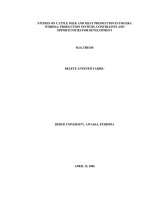

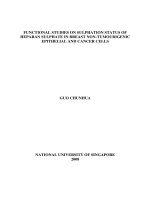
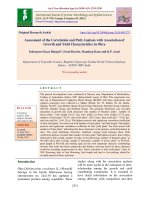

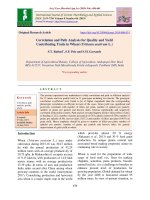
![Studies on correlation and path analysis for grain yield and quality components in foxtail millet [Setaria italica (L.) Beauv.]](https://media.store123doc.com/images/document/2020_01/09/medium_dyd1578574836.jpg)

